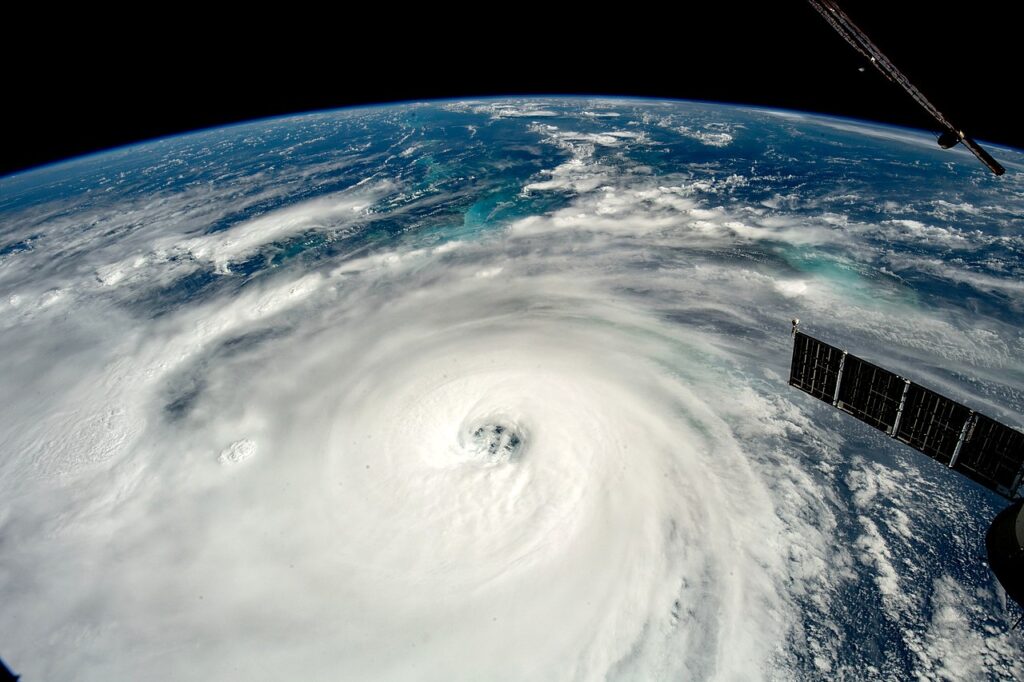
Hurricane Ian, the third-costliest weather disaster on record, as viewed on September 28, 2022, by the crew of the International Space Station. NASA
There is no shortage of evidence that extreme weather conditions resulting from climate change come with a significant financial cost.
Even for those who haven’t yet experienced the costly damages of high winds, torrential rains, and sudden violent shifts in weather patterns, the consequences of extreme weather have increased insurance premiums across the globe.
In January 2023, London-based Gallagher Reinsurance reported that the cost of natural catastrophes in 2022 was $360 billion, of which public and private insurers covered only $140 billion – leaving those who suffered the loss of life and property bearing 61% of the cost out of their own pockets. Over one-third of the losses covered by insurance in 2022 were caused by a single weather event in the U.S., Hurricane Ian. Such severe events are no longer infrequent one-offs; Gallagher Re notes that, “At least three Severe Convective Storm (SCS) outbreaks resulted in a multibillion-dollar insured loss, with 2022 marking the 15th consecutive year with aggregate insured SCS losses topping USD 10bn and the 8th year since 2010 that such losses have topped USD 20bn.”
The Insurance Bureau of Canada lists 11 severe weather events in 2021 that cost $2.1 billion, and insurance premiums are rising to cover losses such as these. Newsweek reported that data gathered by University of Waterloo Climate Risk Research Group Professor Jason Thistlethwaite “suggests some premiums could jump as high as 50 to 100 percent of what they were the previous year. For areas with a higher risk, like Florida, premiums could leap as high as 150 percent what they were the previous year.”
If an objective accounting for the secondary costs of climate change events, including the loss of life, were possible, the financial costs would surely be far greater.
How can financial measures and reporting adapt to a world facing the unpredictable effects of climate change, and help to guide action to less costly outcomes?

Clkr-Free-Vector-Images from Pixabay
An Update for Accounting and Reporting: Giving the Full Account
If our financial journal entries accounted for the cost of environmental damage and remediation – and surely we have the ingenuity to devise objective measures for this – then the numbers would tell a different and very important story about the long-term consequences of our actions. The zero-cost assumption for Nature’s resources fails to account for our depletion of them. These are not resources we can buy and sell like a plot of land – these are resources like air and water that are owned by no one but benefit all. The zero-cost assumption is plainly showing its obsolescence.
Understanding the true cost of climate change, and assigning the costs to those responsible, could motivate more sustainable investments. And then, maybe, Nature would begin to work with us, and deliver far greater riches than our battle against it is now costing us.

Image: Prettysleepy1 on Pixabay
The Account of the Reasons Why
When we work in harmony with Nature, imagine how time would become an account of our love for Nature, and Nature loving us back. Nature has this unique amazing power, that it will never be completely destroyed, although we humans might not like some of the different forms that Nature takes in response to our activities. Fortunately for us, its ultimate indestructibility is a power that Nature freely shares. The Universe has always had, now has, and ever will have its Nature, of which we are part. We humans are sustained by Nature, from which we are born and into which we die – our bodies will be reclaimed by Nature, but memories of us will live into the future. What account do we want to make of our activities, in those memories we bequeath to our children and theirs?
The most sustainable memories would naturally be those that account for Nature, at the very foundation of the accounting we make of our own time-limited human activities and motivations. Nature’s business is to provide us with the basis of, but not the basis for, our account. The account of Nature is the substrate of the human account, but the basis for our own account is the purpose of our account, which is for humans to choose. To continue making our human account, however, we need to establish some generally agreed principles, and soon. Nature won’t be forever patient when we tip its balance, because if there’s one thing that Nature abhors is imbalance.
The Search for Generally Agreed Standards
Accounting standard-setting bodies around the world are increasingly focussed on measuring and reporting progress on ESG (Environment, Social, and Governance) objectives. The global standard-setter IFRS Foundation announced the creation of the International Sustainability Standards Board (ISSB) at the United Nations’ COP26 climate summit in 2021, and other national accounting organizations are following suit. Much work is required, however, to define objectively measurable and generally accepted standards.
Groups like Accounting for Sustainability (A4S), established in 2004 by King Charles III when he was Prince of Wales, may help in the standard-setting process, as will a range of global stakeholders. An aim of A4S is “to inspire action by finance leaders to drive a fundamental shift towards resilient business models and a sustainable economy,” and with increased awareness that resiliency and sustainability are core to future profit potential, many businesses could contribute meaningfully to a workable and effective set of generally agreed standards.
Green financing
In recent years, investor demand for green financing options has grown significantly. Green financing has entered the mainstream, providing loans or investments for environmentally friendly activities such as funding clean energy projects and sustainable infrastructure. The intent of green financing is to advance the target of zero carbon emissions and other environmental objectives such as the United Nations’ 17 Sustainable Development Goals (SDGs).
In March, 2022, Reuters reported on a study that showed over $540 billion in green financing initiatives in 2021, a 100-fold increase in a decade. Green financing is, however, not without controversy, much of which centers on sometimes loosely-applied definitions of “green,” in the absence of a global standard.

Image: GDJ on Pixabay
Sharing the financial burden
Established at the 1992 United Nations ‘Earth Summit’ held in Rio de Janeiro, Principles 6 and 7 of the Rio Declaration acknowledge that wealthier countries should bear a larger and more immediate proportion of the responsibility “to conserve, protect, and restore the health and integrity of the Earth’s ecosystem.” Three decades later, the COP27 summit in 2022 reached an historic agreement to establish a loss and damage fund to help countries vulnerable to and hard hit by floods, droughts, and other climate disasters. While the difficult work of determining the fund’s operation, including its governance, contributors, and beneficiaries has only begun and won’t be presented until COP28 later in 2023, an important precedent has been set.
Shortly before COP27, in 2022 the government of Barbados proposed the Bridgetown Initiative. Barbados, an island nation extremely vulnerable to climate catastrophes and limited economic resources, has suffered not only from climate damage but also from the economic disruption of the Covid-19 pandemic and the ensuing inflation.
The Bridgetown Initiative calls for three types of action:
- Emergency financial liquidity in the form of debt financing, interest relief, and debt servicing relief for loans by Multilateral Development Banks (MDBs) to countries in greatest need;
- Expansion of MDB lending by US$1 trillion; and
- Establishment of a global mechanism for raising reconstruction grants for any country in the immediate aftermath of a climate disaster, and funding for “a multilateral agency that accelerates private investment in the low carbon transition, wherever it is most effective.”
The Time to Turn Ideals into Reality is Now
All eyes will be on COP28 to produce a workable loss and damage fund that, whether it does or doesn’t meet the specifics of the Bridgetown Initiative, at least lives up to the spirit behind it.
There are perhaps two ways to view the future potential of the fund, one being negative and other being positive. The negative view is born of self-interest and would argue that if laws weren’t broken then no compensation is owing, or that if there is to be compensation the burden should be shared equally even though the responsibility for the problem is very much unequal. The positive view is the one that puts any wrongs of the past aside, with the perspective that the spirit of cooperation and international partnerships will unlock the immense potential of Nature for the thriving of today’s children and the generations ahead of them.

Image: Gerd Altman, of Pixabay
We should know, as adults, that two wrongs don’t make a right, and that we will not be remembered fondly for the mess we are leaving to the generations of the future.
Shouldn’t we practise what we preach, when instructing children to clean up their rooms, and do our fair share to clean up the planet? If we have the power to put a human on the Moon, to explore the cosmos, to create a quantum computer, and manipulate the physics of the Universe, surely to goodness we have the power to clean up after ourselves.
It’s the responsible thing to do, and to do positively. We may be pleasantly surprised to discover it’s not a net cost but an investment that will pay unimaginably rich dividends, not far down the road, for everyone’s benefit – and most importantly for the benefit of the children who will carry our hopes and dreams together with theirs into the future.



